One of the advantages (and let’s face it, there aren’t many) to being a freelance writer is that on any given day you can look out the window, see that it’s a lovely afternoon, and say “Fuck it, I’m going to go wander.” You can’t do that very often, of course, if you want to keep beans and tortillas on the table. But just knowing you can say it — and do it — is pretty liberating.
Yesterday I looked out that window, saw that it was a perfectly lovely autumn afternoon, said “Fuck it” (and yeah, I said it right out loud), turned off the computer, grabbed my aging little Fujifilm X10 camera, and walked out the door. I knew exactly where I wanted to go. Sort of.
The Chichaqua Bottoms Greenbelt. I knew it existed. I’d seen it on Google maps. I knew generally where it was located (it’s only about 20 minutes by car from where I live). I had a basic understanding of what was meant by ‘bottoms’ and ‘greenbelt’. But I’d never taken the time to actually go there. Proof, if you needed proof, that I can be a massive fucking idjit.
This might seem silly, but one reason I wanted to visit the place is because of Chichaqua. I’ve mentioned this before, but it’s worth repeating. Some 350 years ago when this area was being explored and mapped by French coureurs de bois and voyageurs, they asked the local Sauk and Meskwaki Indians what the river was called. The river, they were told, was Chicaqua. The French had also heard that same term to describe a skunk,so they assumed that was the name of the river. The French began calling it Rivière Mouffette. Skunk River. And that’s what it’s still called. In fact, chichaqua was a term meaning ‘having a powerful smell.’ The natives had been talking about the wild onions and cabbage that grew along the river banks.
I don’t know why that amuses me so much. But it does.
What’s weird, though, is the Chichaqua Bottoms Greenbelt is no longer a part of the Skunk River. A century ago (give or take a few decades) folks decided to ‘straighten’ the river. Which is a pretty arrogant thing to do. The idea was that a slow-moving, winding, meandering river was inefficient and prone to flooding. So they dug a massive gash in the ground and re-channeled the river. This sort of thing happened all over the world, by the way — not just in the American Midwest. Nobody realized at the time that a slow-moving, meandering river was a good thing for flooding. It localized the flood, which reduced the overall severity. Nobody realized that ‘straightening’ a river would reduce an area’s biodiversity. Hell, nobody knew what biodiversity was, or why it might be a good thing.
So…big gash, straight river. And about 25 miles of the old Skunk was isolated.
See that straight blue line on the map? That’s the current channel of the South Skunk River. It’s basically a long ditch. A very pretty ditch, to be sure, and I love wandering along it. Nature has made interesting and lovely, but it’s still a ditch. That wiggly blue line? That’s the old channel. Nothing even remotely ditch-like about it.
Back in 1960, the county bought up about 9000 acres of the old Skunk River channel. The water had never drained from the old channel; the area had basically become a series of oxbow lakes and bottoms. What the hell are oxbows and bottoms? Glad you asked. That’s an oxbow in the photograph below.
An oxbow is a U-shaped body of water; it occurs naturally in meandering rivers. An oxbow lake is one that’s formed when the U-shaped loop is cut off from the main channel, either because some engineering fuckwit decides to ‘straighten’ the river, or because a big flood (or sometimes an earthquake) will shift the river channel itself. Bottoms, on the other hand, are alluvial lowlands, which probably doesn’t tell you much. It’s what we call that land by a river that floods all the time. Marshy land, mosquito-breeding swamps, rich in sediment. If a river runs through a city, the Bottoms are where the poor folks usually live.
That bench in the photograph below? That’s sitting on bottomland. Oxbow lakes and bottoms. Great for wildlife and flood reduction. Sucks for housing.
After the county bought up the old Skunk River channel, they sort of encouraged it to be more of what it already was — a wildlife habitat. They re-introduced otters, and bobolinks, and wild turkeys, and a few species of endangered turtles. Other species returned on their own, like Pileated Woodpeckers and various raptors. They preserved old trees and planted tree species that used to grow in the area before it became farmland.
And I have to say, they’ve done a fantastic job. The place is completely fucking beautiful. Within the first half hour I was there I saw two Great Blue Herons walking along the dead-end road that leads to the area. Herons on the road. They were apparently gigging for frogs in the marshy ponds just off the blacktop. I saw the first bobolink I’ve ever seen in the wild. I nearly stepped on a Northern Water Snake that was three and a half feet long.
Did I get photos of those critters? No, I didn’t. Why? Because I was too busy looking at them to bring my camera to my eye. I’m rubbish when it comes to wildlife photography. What I did instead was photograph the stuff that didn’t move. You know — trees and all that. The water — which I guess does move, even in oxbow lakes. But the lakes and marshes themselves are pretty stationary. I’m not much better at landscape photography than I am at shooting wildlife. I think that’s partly because the landscape is SO BIG and the camera can only jam a small chunk of it through the lens. Still, these photos will, I hope, give you some small idea of the Chichaqua Bottoms.
I’d only planned to be there a short time. I figured maybe an hour. You know, just a break from work to refresh my mind — then back to the computer. But do you remember that bit I mentioned at the beginning of this post? That bit about one of the few advantages of being a freelance writer is the ability to say “Fuck it, I’m going to go wander”? Well, that’s exactly what I did.
It’s days like this that make the lack of a steady income bearable. Pension plan? Pffft. You can’t put days like this in the bank. You have to spend them when you have them.

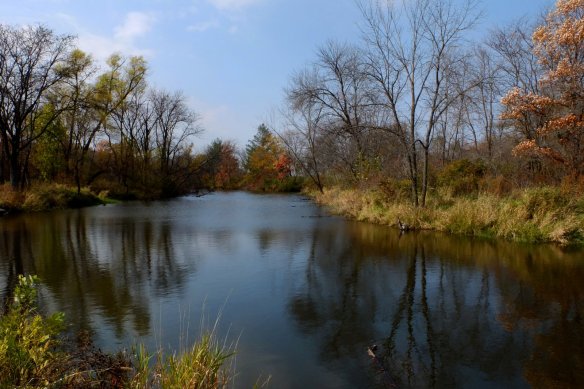

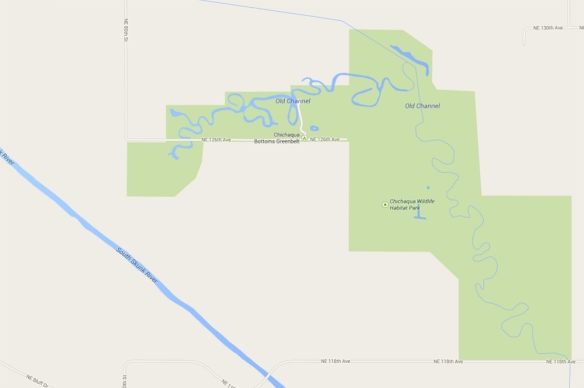
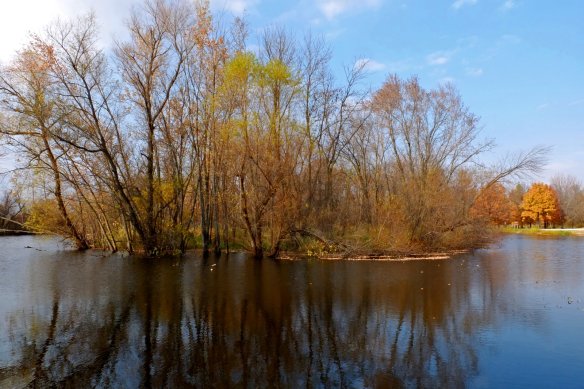
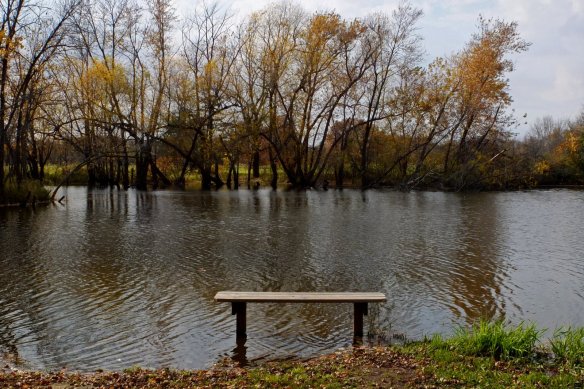
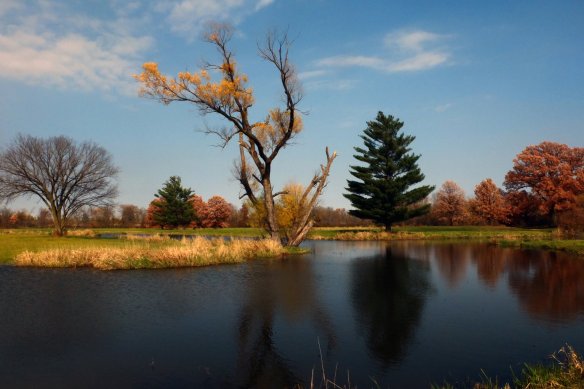
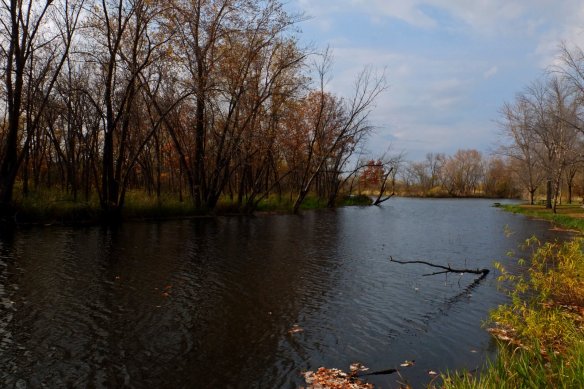
Yes, yes, yes! I love it.
LikeLike
Thanks Kim. It feels like a place that’s somewhat out of time.
LikeLike
That is a beautiful place!
LikeLike
It really is. And I’ve only seen about half of it. I’m hoping to get back this weekend and walk the other half.
LikeLike
Oh yes. I would dearly love to see this place. The fall light and the color makes it even more beautiful. Having the time to see that is worth so much more than dollars, isn’t it?
LikeLike
I really regret not visiting this place earlier. I just learned that the County Park service rents canoes during the season…which ended on the last dayof September. It would be great to see this place from the water.
LikeLike
What a lovely discovery; now you get the anticipation of going back and exploring more and learning the moods of the place…
LikeLike